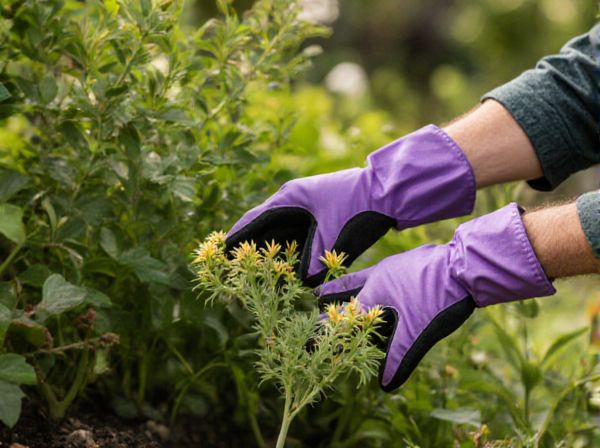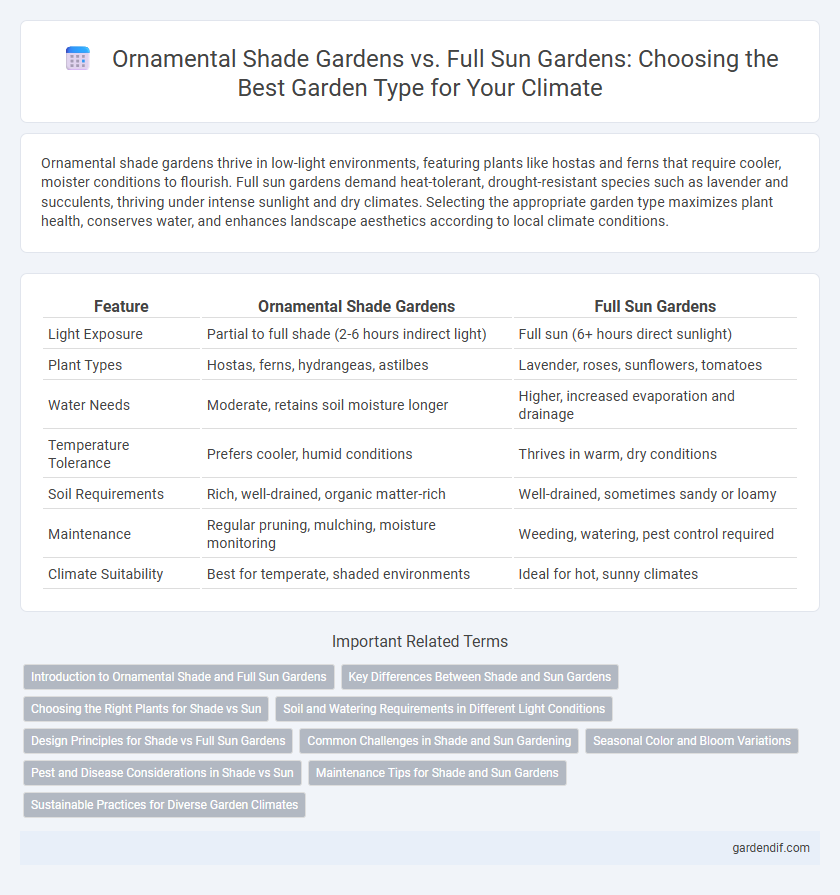
Ornamental Shade Gardens vs Full Sun Gardens Illustration
Ornamental shade gardens thrive in low-light environments, featuring plants like hostas and ferns that require cooler, moister conditions to flourish. Full sun gardens demand heat-tolerant, drought-resistant species such as lavender and succulents, thriving under intense sunlight and dry climates. Selecting the appropriate garden type maximizes plant health, conserves water, and enhances landscape aesthetics according to local climate conditions.
Table of Comparison
| Feature | Ornamental Shade Gardens | Full Sun Gardens |
|---|---|---|
| Light Exposure | Partial to full shade (2-6 hours indirect light) | Full sun (6+ hours direct sunlight) |
| Plant Types | Hostas, ferns, hydrangeas, astilbes | Lavender, roses, sunflowers, tomatoes |
| Water Needs | Moderate, retains soil moisture longer | Higher, increased evaporation and drainage |
| Temperature Tolerance | Prefers cooler, humid conditions | Thrives in warm, dry conditions |
| Soil Requirements | Rich, well-drained, organic matter-rich | Well-drained, sometimes sandy or loamy |
| Maintenance | Regular pruning, mulching, moisture monitoring | Weeding, watering, pest control required |
| Climate Suitability | Best for temperate, shaded environments | Ideal for hot, sunny climates |
Introduction to Ornamental Shade and Full Sun Gardens
Ornamental shade gardens thrive in low-light environments, featuring plants like hostas, ferns, and astilbes that provide lush greenery and texture under tree canopies or shaded patios. Full sun gardens demand at least six hours of direct sunlight daily, supporting sun-loving species such as lavender, coneflowers, and ornamental grasses that flourish in bright, open spaces. Selecting the appropriate garden type optimizes plant health, water usage, and overall landscape aesthetics based on specific climate and sunlight conditions.
Key Differences Between Shade and Sun Gardens
Ornamental shade gardens thrive in low-light conditions, featuring plants like hostas, ferns, and astilbes that demand minimal direct sunlight and cooler temperatures. Full sun gardens require at least six hours of direct sunlight daily and favor sun-loving species such as lavender, coneflowers, and daylilies adapted to higher heat and light intensity. Soil moisture retention and temperature variance differ significantly between the two, with shade gardens maintaining more consistent moisture levels and cooler root zones compared to the drier, warmer environments of full sun gardens.
Choosing the Right Plants for Shade vs Sun
Ornamental shade gardens thrive with plants adapted to low light conditions, such as hostas, ferns, and astilbes, which require consistent moisture and cooler temperatures. Full sun gardens demand sun-loving species like lavender, sedum, and ornamental grasses that tolerate higher temperatures and intense sunlight while needing well-drained soil. Selecting the right plants based on sun exposure optimizes growth, enhances garden aesthetics, and supports local biodiversity by matching species to their ideal microclimates.
Soil and Watering Requirements in Different Light Conditions
Ornamental shade gardens thrive in nutrient-rich, well-draining soil with consistent moisture retention due to limited sunlight, reducing evaporation rates and water needs compared to full sun gardens. Full sun gardens require soil with higher organic matter content that balances moisture retention and drainage, as intense sunlight increases evaporation, demanding more frequent watering to prevent drought stress. Understanding these distinct soil and watering requirements ensures optimal plant health and efficient water use in varying light conditions.
Design Principles for Shade vs Full Sun Gardens
Ornamental shade gardens require design principles that prioritize shade-tolerant plants with broad leaves and varied textures to maximize visual interest in low-light conditions. Full sun gardens demand heat- and drought-resistant species, often incorporating layers of plants with varying heights and bloom times to optimize sunlight exposure and maintain garden vitality. Strategic placement and soil amendment techniques also differ, with shade gardens benefiting from moisture-retentive soils and full sun gardens requiring well-draining substrates to prevent root stress.
Common Challenges in Shade and Sun Gardening
Shade gardens often face challenges such as limited photosynthesis due to low light, leading to slower plant growth and increased moisture retention that can encourage fungal diseases. Full sun gardens struggle with water evaporation, soil drying, and heat stress, which necessitate careful watering and drought-tolerant plant selections. Both garden types require tailored soil amendments and pest management strategies to maintain plant health in their distinct microclimates.
Seasonal Color and Bloom Variations
Ornamental shade gardens typically feature plants like hostas, ferns, and astilbes that thrive in low light, offering rich foliage colors and staggered bloom times from spring to fall. Full sun gardens support vibrant, heat-tolerant plants such as lavender, marigolds, and coneflowers, which provide bright, consistent blooms primarily during late spring and summer seasons. Seasonal color in shade gardens often includes deeper greens and purples with subtle blooms, while sun gardens burst with bold yellows, reds, and oranges that peak during warmer months.
Pest and Disease Considerations in Shade vs Sun
Ornamental shade gardens typically experience lower pest infestations due to cooler, moister conditions that discourage many common sun-loving pests such as aphids and spider mites. Full sun gardens often face higher risks of diseases like powdery mildew and leaf spot, which thrive in warm, dry environments combined with intense sunlight. Effective pest and disease management requires selecting shade-tolerant plants with natural resistance in shade gardens, while in full sun gardens, implementing crop rotation and timely fungicide applications can reduce outbreaks.
Maintenance Tips for Shade and Sun Gardens
Ornamental shade gardens require regular monitoring of soil moisture and the use of organic mulch to retain humidity and reduce weed growth, while sun gardens benefit from drought-resistant plant selections and more frequent watering during hot, dry periods. Pruning shade-loving plants like hostas helps prevent overcrowding and improves airflow, whereas sun-exposed gardens need deadheading and trimming to encourage continuous blooming. Both garden types demand tailored fertilization schedules, with shade gardens often needing slower-release nutrients and sun gardens benefiting from balanced, higher-nitrogen fertilizers to support vigorous growth.
Sustainable Practices for Diverse Garden Climates
Ornamental shade gardens thrive with drought-tolerant, native plants that reduce water usage and support local biodiversity, making them ideal for cooler, shaded environments. Full sun gardens benefit from heat-resistant species and mulching techniques that conserve soil moisture and minimize the need for chemical fertilizers. Incorporating permaculture principles and organic composting in both garden types enhances soil health and climate resilience across diverse regional conditions.
Ornamental Shade Gardens vs Full Sun Gardens Infographic

 gardendif.com
gardendif.com